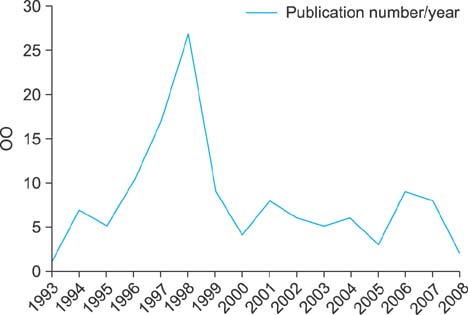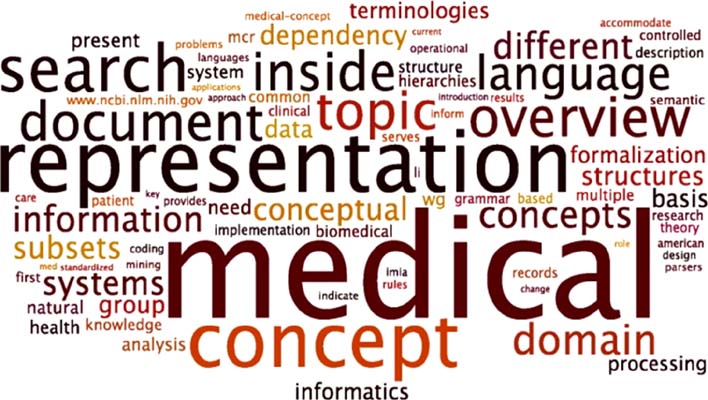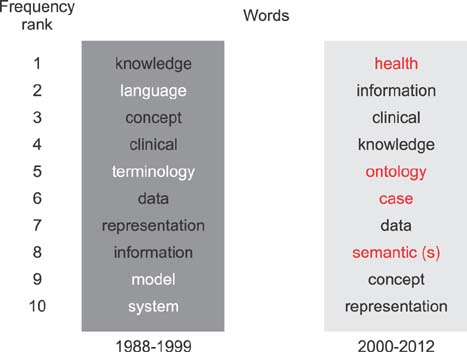Healthc Inform Res.
2013 Dec;19(4):235-242. 10.4258/hir.2013.19.4.235.
From Concept Representations to Ontologies: A Paradigm Shift in Health Informatics?
- Affiliations
-
- 1Institute for Medical Informatics, Statistics and Documentation, Medical University of Graz, Graz, Austria. stefan.schulz@medunigraz.at
- 2European Centre for Disease Prevention and Control, Stockholm, Sweden.
- 3Department of Medical Informatics, Academic Medical Center, Amsterdam, The Netherlands.
- 4Department of Biomedical Engineering, Linkoping University, Linkoping, Sweden.
- 5National Library of Medicine, National Institutes of Health, Bethesda, MD, USA.
- KMID: 2229498
- DOI: http://doi.org/10.4258/hir.2013.19.4.235
Abstract
OBJECTIVES
This work aims at uncovering challenges in biomedical knowledge representation research by providing an understanding of what was historically called "medical concept representation" and used as the name for a working group of the International Medical Informatics Association.
METHODS
Bibliometrics, text mining, and a social media survey compare the research done in this area between two periods, before and after 2000.
RESULTS
Both the opinion of socially active groups of researchers and the interpretation of bibliometric data since 1988 suggest that the focus of research has moved from "medical concept representation" to "medical ontologies".
CONCLUSIONS
It remains debatable whether the observed change amounts to a paradigm shift or whether it simply reflects changes in naming, following the natural evolution of ontology research and engineering activities in the 1990s. The availability of powerful tools to handle ontologies devoted to certain areas of biomedicine has not resulted in a large-scale breakthrough beyond advances in basic research.
Keyword
Figure
Reference
-
1. International Medical Informatics Association [Internet]. Geneva, Switzerland: International Medical Informatics Association;c2013. cited at 2013 Nov 15. Available from: http://www.imia-medinfo.org/new2/.2. Cimino JJ, Smith B. Introduction: international medical informatics association working group 6 and the 2005 Rome conference. J Biomed Inform. 2006; 39(3):249–251.
Article3. Schuemie MJ, Talmon JL, Moorman PW, Kors JA. Mapping the domain of medical informatics. Methods Inf Med. 2009; 48(1):76–83.
Article4. Scopus [Internet]. Amsterdam, The Netherlands: Elsevier;c2013. cited at 2013 Nov 15. Available from: http://www.scopus.com.5. Ultimate Research Assistant [Internet]. Herndon (VA): Andy Hoskinson, LLC;cited at 2013 Nov 15. Available from: http://ultimate-research-assistant.com.6. Wordle [Internet]. [unknown]: Jonathan Feinberg;c2013. cited at 2013 Nov 15. Available from: http://www.wordle.net/.7. Harzing AW. Publish or Perish [Internet]. [unknown]: Harzing.com;c2013. cited at 2013 Nov 15. Available from: http://www.harzing.com/pop.htm.8. Textalyzer [Internet]. [unknown]: textalyzer.net;c2004. cited at 2013 Nov 15. Available from: http://textalyser.net/.9. Datagle [Internet]. [unknown]: Datagle LLC;cited at 2013 Nov 15. Available from: http://www.datagle.com/.10. Smith B, Ashburner M, Rosse C, Bard J, Bug W, Ceusters W, et al. The OBO Foundry: coordinated evolution of ontologies to support biomedical data integration. Nat Biotechnol. 2007; 25(11):1251–1255.
Article11. Ashburner M, Ball CA, Blake JA, Botstein D, Butler H, Cherry JM, et al. Gene ontology: tool for the unification of biology. The Gene Ontology Consortium. Nat Genet. 2000; 25(1):25–29.12. International Health Terminology Standards Development Organisation. SNOMED CT [Internet]. Copenhagen, Denmark: International Health Terminology Standards Development Organisation;c2013. cited at 2013 Nov 15. Available from: http://www.ihtsdo.org/snomed-ct.13. Bodenreider O. The Unified Medical Language System (UMLS): integrating biomedical terminology. Nucleic Acids Res. 2004; 32(Database issue):D267–D270.
Article14. Rosse C, Mejino JL Jr. A reference ontology for biomedical informatics: the Foundational Model of Anatomy. J Biomed Inform. 2003; 36(6):478–500.
Article15. Smith B, Ceusters W, Klagges B, Kohler J, Kumar A, Lomax J, et al. Relations in biomedical ontologies. Genome Biol. 2005; 6(5):R46.16. Cimino JJ. Desiderata for controlled medical vocabularies in the twenty-first century. Methods Inf Med. 1998; 37(4-5):394–403.
Article17. Rector AL. Clinical terminology: why is it so hard? Methods Inf Med. 1999; 38(4-5):239–252.
Article18. Smith B. From concepts to clinical reality: an essay on the benchmarking of biomedical terminologies. J Biomed Inform. 2006; 39(3):288–298.
Article19. Collier N, Doan S, Kawazoe A, Goodwin RM, Conway M, Tateno Y, et al. BioCaster: detecting public health rumors with a Web-based text mining system. Bioinformatics. 2008; 24(24):2940–2941.
Article20. Gangemi A, Guarino N, Masolo C, Oltramari A, Schneider L. Sweetening ontologies with DOLCE. Knowledge engineering and knowledge management: ontologies and the Semantic Web. Heidelberg, Germany: Springer;2002. p. 166–181.21. Brown EG, Wood L, Wood S. The medical dictionary for regulatory activities (MedDRA). Drug Saf. 1999; 20(2):109–117.
Article22. Stearns MQ, Price C, Spackman KA, Wang AY. SNOMED clinical terms: overview of the development process and project status. Proc AMIA Symp. 2001; 662–666.23. Smith B, Kusnierczyk W, Schober D, Ceusters W. Towards a reference terminology for ontology research and development in the biomedical domain. In : Proceedings of KR-MED; 2006 Nov 8; Baltimore, MD. p. 56–67.24. Yu AC. Methods in biomedical ontology. J Biomed Inform. 2006; 39(3):252–266.
Article25. Ceusters W, Smith B, Kumar A, Dhaen C. Ontology-based error detection in SNOMED-CT. Stud Health Technol Inform. 2004; 107(Pt 1):482–486.26. Sadegh-Zadeh K. Fuzzy health, illness, and disease. J Med Philos. 2000; 25(5):605–638.
Article27. Brinkman RR, Courtot M, Derom D, Fostel JM, He Y, Lord P, et al. Modeling biomedical experimental processes with OBI. J Biomed Semantics. 2010; 1:Suppl 1. S7.
Article28. Ferreira JD, Pesquita C, Couto FM, Silva MJ. Bringing epidemiology into the Semantic Web. In : Proceedings of the 3rd International Conference on Biomedical Ontology; 2012 Jul 21-25; Graz, Austria.29. Porta M. A dictionary of epidemiology. 5th ed. New York (NY): Oxford University Press;2008.30. European Commission. Semantic interoperability for better health and safer healthcare: research and development roadmap for Europe. Luxembourg: European Commission;2009.31. Gillam M, Feied C, Handler J, Moody E, Shneiderman B, Plaisant C, et al. The healthcare singularity and the age of semantic medicine. In : Hey T, Tansley S, Tolle K, editors. The fourth paradigm: data-intensive scientific discovery. Redmond (WA): Microsoft Research;2009. p. 57–64.32. Smith B. Beyond concepts: ontology as reality representation. In : Proceedings of the 3rd International Conference on Formal Ontology in Information Systems; 2004 Nov 4-6; Torino, Italy. p. 73–84.33. W3C OWL Working Group. OWL 2 Web ontology language document overview (second edition) [Internet]. [unknown]: W3C;c2012. cited at 2013 Nov 15. Available from: http://www.w3.org/TR/owl2-overview/.34. Klein GO, Smith B. Concept systems and ontologies: recommendations for basic terminology. Trans Jpn Soc Artif Intell. 2010; 25(3):433–441.
Article35. Schulz S, Jansen L. Formal ontologies in biomedical knowledge representation. Yearb Med Inform. 2013; 8(1):132–146.
Article36. Smith B. Applied ontology: a new discipline is born. Philos Today. 1998; 12(29):5–6.37. Berners-Lee T, Hendler J, Lassila O. The Semantic Web. Sci Am. 2001; 284(5):28–37.
Article38. Baader F, Calvanese D, McGuinness DL, Nardi D, Patel-Schneider P. The description logic handbook: theory, implementation, and applications. 2nd ed. Cambridge, UK: Cambridge University Press;2007.39. Gennari JH, Musen MA, Fergerson RW, Grosso WE, Crubezy M, Eriksson H, et al. The evolution of Protégé: an environment for knowledge-based systems development. Int J Hum Comput Stud. 2003; 58(1):89–123.
Article40. Rector AL, Glowinski AJ, Nowlan WA, Rossi-Mori A. Medical-concept models and medical records: an approach based on GALEN and PEN&PAD. J Am Med Inform Assoc. 1995; 2(1):19–35.
Article41. IMIA LaMB Working Group [Internet]. Mountain View (CA): LinkedIn;c2013. cited at 2013 Nov 15. Available from: http://www.linkedin.com/groups/IMIA-Medical-Concept-Representation-Working-3680642/about.
- Full Text Links
- Actions
-
Cited
- CITED
-
- Close
- Share
- Similar articles
-
- The Comparison Analysis of Opinions towards the Concept of Consumer Health Informatics among Korean and American Health Informatics Academic Society Members
- Improving the CONTES method for normalizing biomedical text entities with concepts from an ontology with (almost) no training data
- Megatrends and Perspectives of Emerging Medical Services
- A Paradigm Shift in the Healthcare Delivery System with the Emergence of the 'Ambient Care' Environment
- Sense of Coherence in Salutogenic Paradigm




